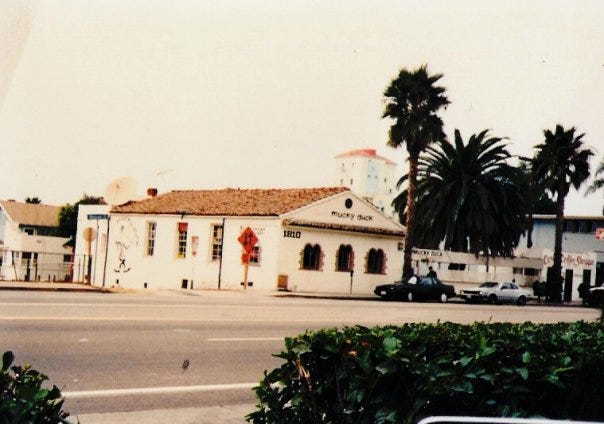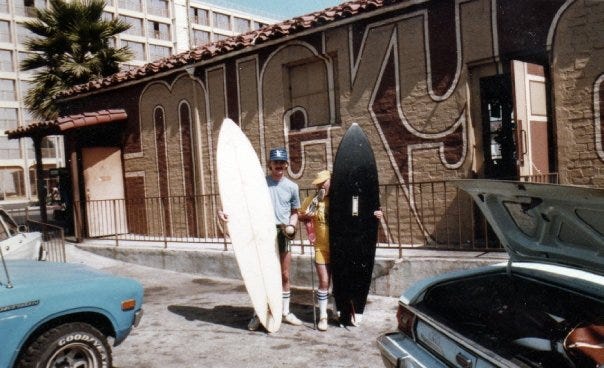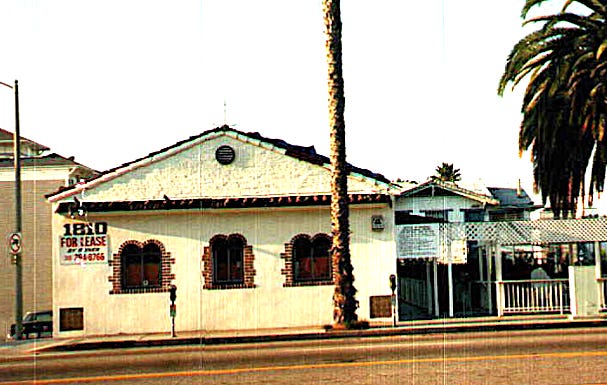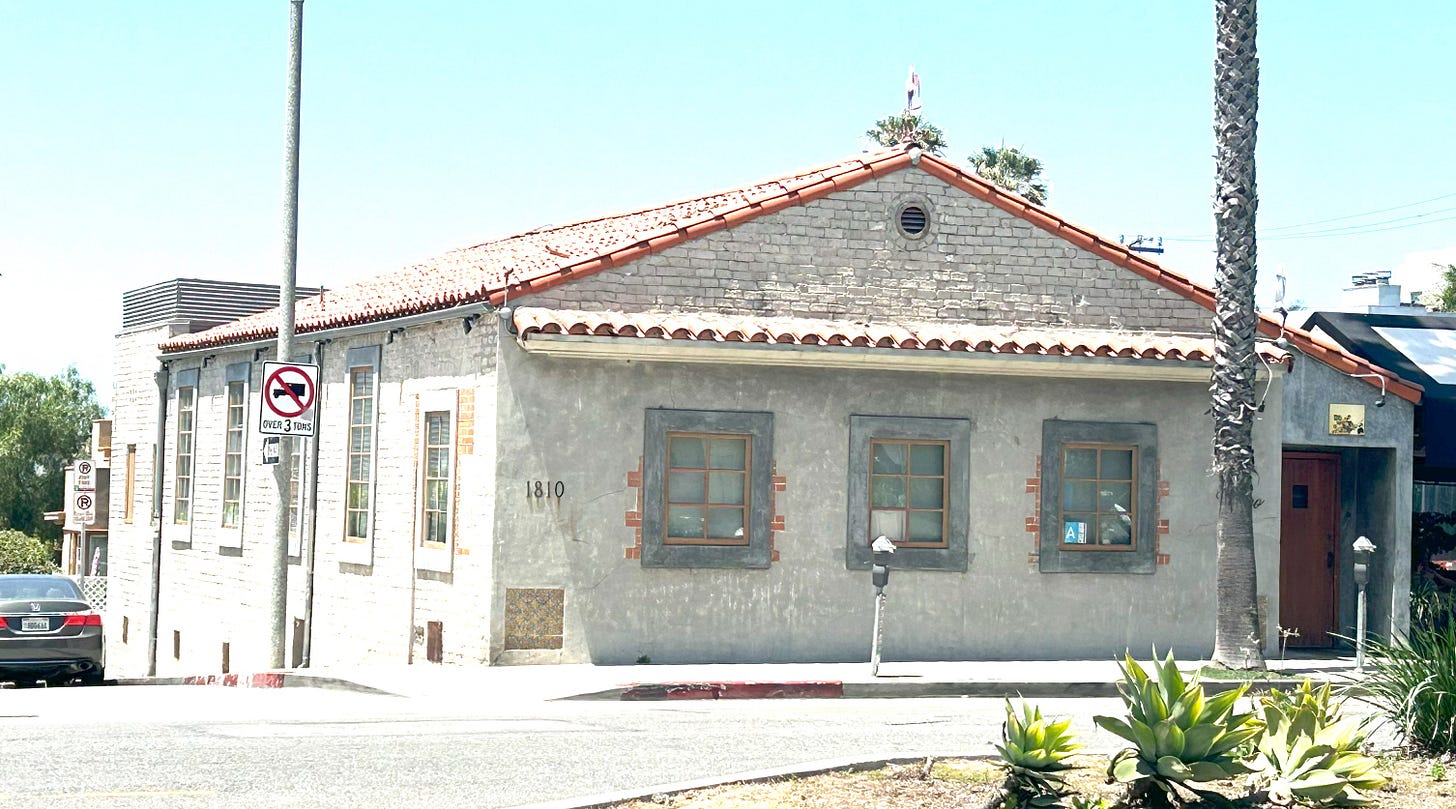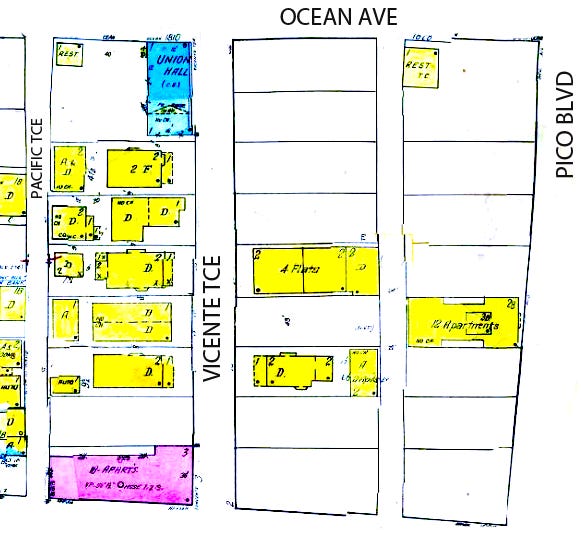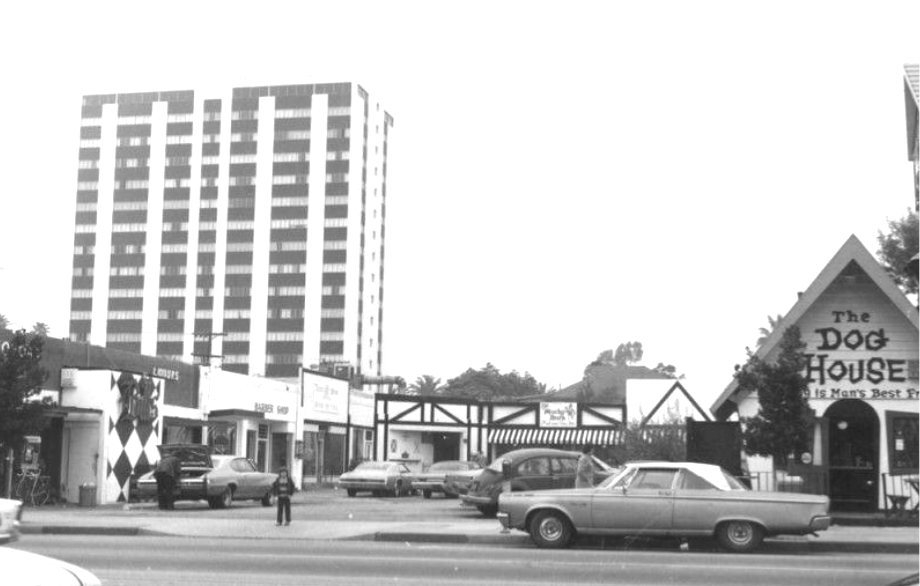The 1810 Ocean Ave building is constructed in 1928 as an Automobile Club branch office. While unfortunately extensively altered, the building still exists and is now occupied by Capo, an upscale Italian restaurant.
Automobile Club Branch Office (1928 -1937)
The 1928 building is the eighteenth branch office of the Automobile Club of Southern California (ACSC).1 The one-story Spanish-style building is designed by Carleton Monroe Winslow,2 one of Southern California’s 1920s architectural elite. Winslow designs many residences, churches, and commercial buildings from San Diego to Santa Barbara. He is known mostly for his Spanish Colonial Revival style – often with a touch of Art Deco influence.
The property3 is owned by C. Albert Brown, and the building is erected by C. L. Freeman4 for $5,000.
More than 3,720 customers of the Bay District are served by the Santa Monica ACSC branch office.5 At the beginning of every year, automobile owners visit to get their new license plates. In 1937, the Santa Monica ACSC branch office moves to Wilshire and 20th.
The Little Chapel on the Highway (1938 -1939)
From 1938 to 1939, the building is The Little Chapel on the Highway, a church run by the Rev. Frederick L. Pyman6 of the Independent Bishops Western Regional Diocese. During this time frame, the ecumenical Pyman is an independent high-church Lutheran. Pyman often ministers outside the margins.
Electrical Workers Union Hall (1941 - 1974)
In 1941, the property - 2 “stucco” buildings on a 100-ft x 72-ft lot - is up for sale at $9,500.
From 1941 to 1974, the building is the offices and dispatch hall of the International Brotherhood of Electrical Workers (IBEW) Union Local 11, AFL district #3. In 1957, IBEW encloses the front of the building on Ocean Ave and moves the building entrance to the north side.
Ye Olde Mucky Duck (1979 -1989)
In 1973, a City 25-year moratorium on commercial uses in residential zoned districts expires, and 1810 Ocean Ave’s commercial use becomes non - conforming.7 In 1979, the Planning Commission approves a Conditional Use Permit (CUP) to operate a pub in a residential (R4) zone.8 The Brigadoon people9 open Ye Olde Mucky Duck.10
In 1985, Ethel Bassett and Gregory J. McElroy purchase the Mucky Duck. McElroy runs several rowdy local venues. A stage for bands (live entertainment) is installed. Vicente Terrace neighbors complain.
In August 1989, the CUP that allows the pub to operate expires. They permanently lose their State alcohol license. Mucky Duck closes.
Vacant (1989 - 1997)
In 1989, with the approval of the Coastal Commission, Ocean Ave zoning changes from high-density-residential (R4) to residential-visitor-commercial (RVC). Restaurateur Hans Rockenwagner makes an application to remodel the Mucky Duck and Cora’s Coffee Shoppe into a single French restaurant. There are zoning and parking issues, and the Vicente Terrace neighbors are wary. Rockenwagner decides to open a restaurant in the 1989 Edgemar development.
Capo (1998 - now)
In 1998, veteran West Los Angeles restaurateurs Marvin Zeidler and Bruce Marder open old school Italian restaurant Capo. They also run Cora’s Coffee Shoppe.
The Automobile Club of Southern California (ACSC), founded in 1900, is one of the nation's first automobile clubs. Few Southern Californians own automobiles in 1900. The founders envision a private social club where they can race their automobiles among themselves, as well as provide an opportunity to market their real estate assets. However, the Auto Club soon rebrands itself as a public-oriented organization. By 1906, the Auto Club begins charting California's roads. In 1908, the Auto Club begins issuing license plates as an agent of the State of California. In 1913, the first Auto Club branch office opens in San Diego. In 1923, the Auto Club headquarters building opens at Adams Boulevard and Figueroa Street. The ACSC is a member of the American Automobile Association (AAA).
Carleton Monroe Winslow (1876 - 1946), also known as Carleton Winslow Sr., is an American architect, and key proponent of Spanish Colonial Revival architecture in Southern California in the early 20th century. Amongst many buildings, Winslow is credited with designing the Santa Barbara ACSC branch office in 1921, and the Riverside ACSC branch office in 1929. He adds the Chapel of Saint Ambrose to the Saint Augustine-by-the-Sea Church, Santa Monica, in 1941.
The 100-ft x 72-ft property is on Ocean Ave between Vicente Terrace and Pacific Terrace. Lots 19 and 20 of Tract 1111 - a 1911 re-subdivision of Carl F. Schader’s 1910 Vicente Terrace Tract. There are two buildings on the property - 1802 Ocean Ave and 1810 Ocean Ave. They often leased to different operators. Cora’s Coffee Shoppe is a long-term tenant at 1802 Ocean Ave.
Claude Leever Freeman (1879–1965). Contractor for many important Santa Monica buildings.
The first automobile in Los Angeles arrives in 1897. By 1904, 1,600 motor vehicles cruise the streets of Los Angeles. The maximum speed limit is 8 mph in residential areas and 6 mph in business districts. By 1915, Los Angeles County counts 55,217 motor vehicles. The county leads the world in per capita ownership of automobiles.
Frederick Littler Pyman (1901 - 1993). Born in Liverpool, England. His parents, John W. and Clara Pyman, under their professional names of Clara Reid and John Power, are active in the London theatre scene. They move to Culver City in 1929, where they are motion picture actors. Fred Pyman studies for ordination through the Pacific Conference of the English Lutheran Conference and is ordained in the Evangelical Lutheran Church for St. John's Community Church in Culver City in 1935. In 1936, he marries Louise M. Jagelski (1905 - 1984) - they have three children, but divorce in 1967. Fred Pyman joins the Protestant Orthodox Western Church in America, founds the Evangelical Orthodox Church in Santa Monica, and then the Universal Episcopal Church. Archbishop Frederick Littler Pyman dies in Los Gatos.
In 1946, Ocean Ave is re-zoned to “residential” use. In 1948, the City adopts an ordinance requiring all commercial uses in residential districts to be removed within 25 years. When 1973 ever so quickly rolls around, a Conditional Use Permit (CUP) is required to extend the non-conforming use.
In 1979, the Ocean Ave building has been vacant for 5 years. While now located in high-density residential (R4) zoning, the lot is too small for motel or hotel development. The approved Conditional Use Permit (CUP) extends the commercial use for 10 years. A condition of the CUP requires that the coffee shop (Cora’s) remain open.
Michael J. Higgins & Donald G. DeLong of Brigadoon, Inc. dba Ye Olde Mucky Duck.
Santa Monica’s first British pub, the 1950s Mucky Duck, is in an L-shaped Tudor building in a retail center behind the Dog House hot dog stand on 3rd and Wilshire. The Black Swan is a popular name for pubs in England - the informal term for the Black Swan is Mucky Duck. By 1970, Mucky Duck is operated by Englishmen Van McDuff and Wally Parsons. The retail center is torn down in 1974.
Across 3rd St from the Mucky Duck is another pub, Brigadoon. The Brigadoon space is now Michael's - opened by Michael McCarty in 1979.







